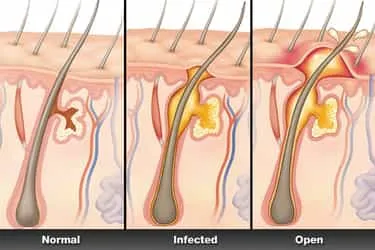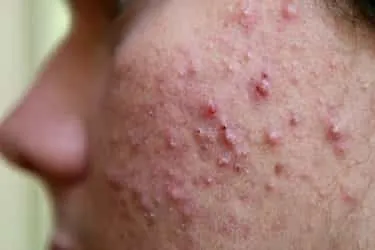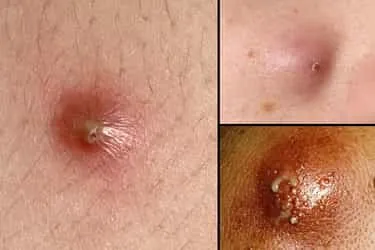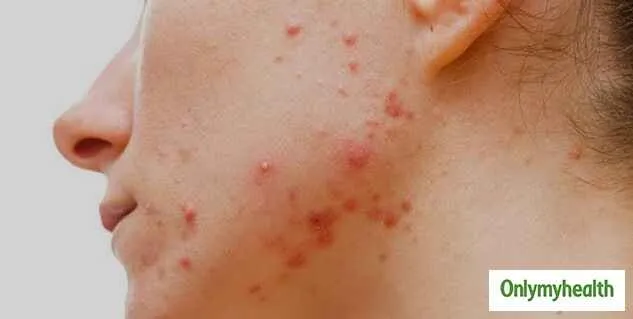Boil is a skin condition that appears as an inflammatory lesion. It can be painful, itchy, and even disfiguring. The appearance of boil is of no consequence, but how you treat it is everything. A boil or furuncle is a type of skin infection that develops in the hair follicle or some other sweat gland-associated structure. For many people, boils occur once in a lifetime and they do not need much treatment beyond home remedies such as warm compresses or green tea bags. But if left untreated, boils may return frequently. This article will help you understand what causes boil and how to get rid of it completely with ease.
What Causes Boils?
Boil is a skin infection caused by bacterial growth. A boil is a type of infection that occurs in the hair follicle or other sweat gland-associated structures. These infections can also occur in the deeper tissues surrounding the skin. The bacteria that cause boils are Staphylococcus aureus and Streptococcus pyogenes. Boil, also known as furuncles, are a result of blocked pores and the accumulation of bacteria, sebum, and keratin. The bacteria in the skin form a hard plug that leads to inflammation, redness, and pus formation. A boil is a localized infection of the skin and hair follicle that is deep enough to be seen and felt as a bump under the skin.

Image Source
Warning Signs of Boil Formation:
Boils are usually pea-sized, but can grow as large as a golf ball. Symptoms can include:
Source
- Excessive warmth - Boils are generally hot to the touch. The skin around the boil may be red and feel warm to the touch, as well.
- Redness - When a boil is forming, the surrounding skin will become red and inflamed. You may even notice the skin around the area getting puffy.
- Swelling - As the boil grows, it may begin to swell and expand. You may even notice the skin around the boil becoming puffy.
- Open or draining wound - When a boil ruptures, it may ooze a yellowish liquid. This may be accompanied by a foul smell.
- Itching - Some people experience mild itching as the boil is forming. The itching may become more noticeable as the boil grows.
- Pain - Some people experience pain when a boil is forming. The pain may become more severe as the boil grows.
Boil Treatment Guide:
- Preventive Measures - The first thing you have to do is keep the boils clean. This ensures the boils do not get infected. If you have sensitive skin, you can use a mild cleanser to clean the boils. If you have normal or oily skin, you can use warm water and a mild soap.
- Oils and Gels - You can apply a bit of tea tree oil or lavender oil on the boil to reduce the pain. You can also use an aloe vera gel to reduce the pain.
- Coat It Up - You can also use a bandage to protect the boil and keep it covered. If there is pus, you should clean the boil with warm water and salt. If there is no pus, you can use the salt water as a compress.
- Avoid Scratching - You should avoid scratching the boil as it can lead to an infection.
- Antibiotics - If the boil is accompanied by high fever, you can take antibiotics after consulting a doctor.

Image Source
Home Remedies for Boil formation:
- Apple Cider Vinegar - This home remedy can help reduce the boil formation. Take a cotton ball and dip it in apple cider vinegar. Place the cotton ball on the boil for about 3-4 minutes. This should reduce the boil formation.
- Green Tea - Green tea is a great home remedy to prevent the boil formation. Boil a cup of water and let it cool slightly. Take a teaspoon of green tea leaves and add it to the water. Let it steep for about 10 minutes. Take this tea and let it cool. Apply this solution on the boil for about 5 minutes. This should reduce the boil formation.
- Horsetail Tea - Horsetail tea is another great home remedy to prevent the boil formation. You can either take the tea leaves or boil the tea bag and take it. This can reduce the boil formation.
- Oregano Oil - Oregano oil is a great home remedy to prevent and reduce the boil formation. You can either apply it directly to the boil or take it orally.
Conventional Medication for Boil Treatment:
- Antibiotics - The most recommended medication for treating and preventing boil formation is antibiotics. Antibiotics kill the bacteria and prevent the formation of boil.
- Hydrogen peroxide - Hydrogen peroxide is also an effective treatment for boil. You should apply hydrogen peroxide on the boil and let it dry. You can use hydrogen peroxide as a disinfectant to clean the boil and prevent it from getting infected.
- Boil Removal - If the boil is already formed and painful, you can use a sterile needle to remove the pus inside the boil. You can use a clean, sterilized needle and remove the pus inside the boil.
Conclusion:
Boil is a skin infection that is caused by bacterial growth. You can prevent and reduce the boil formation by taking preventive measures such as cleaning the boil, using antiseptics, and taking antibiotics. If the boil is formed, you can use home remedies such as green tea, apple cider vinegar, and horsetail tea to prevent it from getting infected. These should be followed with conventional medication such as antibiotics to treat the boil.
Some Reference:
https://en.m.wikipedia.org/wiki/Boil
https://www.healthline.com/health/home-remedies-for-boils
https://www.webmd.com/skin-problems-and-treatments/ss/slideshow-boils
This post 5% beneficiary of @stemsocial
Thank you so much for reading my post. Please give your feedback if you comment in my post then I will be motivated to give away more new posts....

